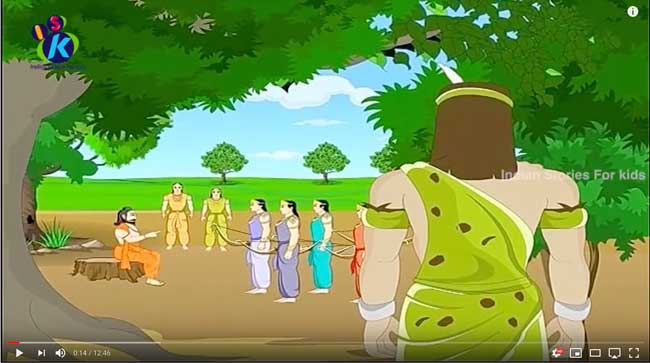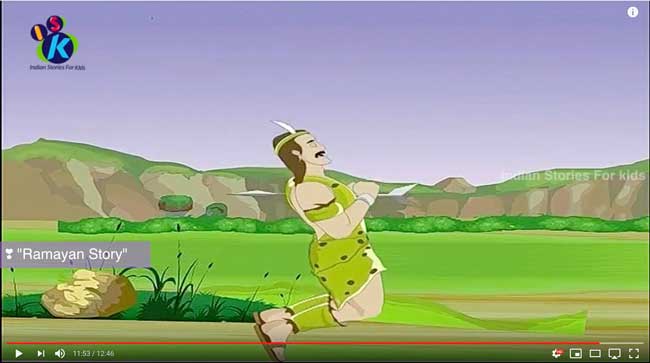Watch this story on Youtube including the self-mutilation scene [11:32]: Eklavya (Mahabharat) Kahaniyaa video channel: Moral Stories For Children
URL: https://www.youtube.com/watch?v=Tgl0L401VkI
Date visited: 2 March 2023
3D Animation For Children forms the best Mahabharat Short Movie In Hindi from Kids Cartoon Movies >>
गुरू भक्ति /Gurū bhakti
Author: बाल चित्र समिति की भेंट ; संवाद और पटकथा, केदार शर्मा ; निर्माता, महेन्द्र नाथ ; निर्देशक, राजेन्द्र कुमार. ; ; Rajendra Kumar, (Children’s film director); Children’s Film Society (India),
Publisher: Mumbai : Children’s Film Society, India, [2008?]
Edition/Format: DVD video : PAL color broadcast system : Juvenile audience : State or province government publication : HindiSummary: “Eklavya, a tribal boy, wants to learn archery from the great teacher Dronacharya. Unable to do so because he lacks royal blood, he spies upon the teacher Dronacharya when he is teaching the Kauravas and Pandavas. He builds a mud statue of Dronacharya, considers him his guru in his heart and practices archery diligently. He soon becomes a great archer, better than even those being taught by the Guru himself. Based on a story from the epic Mahabharata, Guru Bhakti impresses upon the kids the importance of devotion and determination in reaching ones goals.”–Publisher’s description.
Source: गुरू भक्ति /Gurū bhakti, Worldcat.org
URL: https://www.worldcat.org/title/guru-bhakti/oclc/1038721444
Date visited: 1 July 2020
The story of Ekalavya (Eklavya) the archer prodigy
The episode […] is that of Ekalavya, who being a Nishada [Sanskrit Niṣāda, “tribal, hunter, mountaineer, degraded person, outcast”], had to give his thumb as a fee to the brahmin guru thus terminating his skill as an archer.
Source: The epic of the Bharatas by Romila Thapar
URL: http://www.india-seminar.com/2010/608/608_romila_thapar.htm
Date visited: 11 July 2021
“The forest was never far away from habitation. For instance, excavations of the settlements at Atranjikhera and Hastinapur, which are not too far from Delhi, have yielded evidence of a large variety of forest trees. The Buddhist Canon states that aside from the village and its outskirts, the rest of the land is jungle. Travelling from one town to another meant going through a forest. Therefore, when in exile, the forest was not a physically distant place, although distant in concept.“ – Romila Thapar (Emeritus Professor of History, Jawaharlal Nehru University) in “Forest dwellers in early India – myths and ecology in historical perspective” | Learn more >>
All tribal communities are not alike. They are products of multiple historical and social conditions. They belong to four different language families, and several different racial stocks and religious moulds. They have kept themselves apart from feudal states and brahminical hierarchies for thousands of years. In Indian epics, such as the Ramayana, the Mahabharata and the Puranas, there are many references to interactions and wars between the forest or hill tribes and the Hindus. […]
The epics of the Ramayana, the Mahabharata, the Puranas, Samhitas, and other so-called sacred books refer to adivasis as Rakshasha (demons), Vanara (monkeys), Jambuvan (boar men), Naga (serpents), Bhushundi Kaka (crow), Garuda (king of eagles), etc. In medieval India, they were called derogatorily as Kolla, Villa, Kirata, Nishada, and those who surrendered or were subjugated were termed as Dasa (slave) and those who refused to accept the bondage of slavery were termed as Dasyu (a hostile robber). […]
Source: This is our homeland
URL: https://www.equitabletourism.org/files/fileDocuments493_uid10.pdf
Date visited: 23 December 2018

Human trafficking is a crime. To report in India, call Shakti Vahini
+91-11-42244224, +91-9582909025 or the national helpline Childline on 1098.
National Programme for Child Labour Free India | PDF-Repository (70 KB) >>
“As per a study on human trafficking, the state of Jharkhand has emerged as India’s trafficking hub with thousands of tribal women and girls being trafficked out of the state each year to Delhi, Punjab, Haryana and beyond [while] human traffickers are also involved in many cases of missing children.” – The Wire | Shakti Vahini | Tourism locations | Adivasi tribal bondage slavery trafficking (Safe search) >>
NEW DELHI: Dronacharya, Guru of Pandavas and Kauravas in the epic Mahabharata, came in for some harsh contemporary scrutiny in the Supreme Court, with the apex court terming as shameful his action in seeking the right thumb of tribal Eklavya to clear the way for his favourite, Arjun, to emerge as the best archer of the times.
“This was a shameful act on the part of Dronacharya. He had not even taught Eklavya, so what right had he to demand ‘guru dakshina’, and that too of the right thumb of Eklavya so that the latter may not become a better archer that his favourite pupil Arjun?”, asked a bench comprising Justices Markandey Katju and Gyan Sudha Mishra. For them, the episode in the Adiparva section of the immortal epic constituted the “well well-known example of the injustice” to tribals. […]
The Times of India, 6 January 2011
URL: https://timesofindia.indiatimes.com/india/Dronacharyas-act-was-shameful-says-SC/articleshow/7226157.cms?utm_source=contentofinterest&utm_medium=text&utm_campaign=cppst
Date visited: 11 July 2021
[Bold typeface added above for emphasis]

Learn more

© Economic Times
Adverse inclusion | Colonial policies | Customs | Rights of indigenous peoples
Archery | Games and leisure time | Hunter-gatherers | Martial art | Nature and wildlife
Biodiversity | Ethnobotany | Trees
Childhood | Childrens rights: Childrens right to education | UNICEF India | Safe search
Ekalavya (Eklavya) | Video | Ekalavya discussed in an interview with noted Kenyan writer Ngugi wa Thiong’o
Ekalavya and Drona shape collective expectations from a teacher and a student
Forest Rights Act (FRA) | Nishad (Nishada, Sanskrit Niṣāda, “tribal, hunter, mountaineer, degraded person outcast”) | Vanavasi (Vanvasi, Vanyajati)
Government of India | India’s Constitutional obligation to respect their cultural traditions
History | Modernity | Romila Thapar
Human Rights Commission (posts) | www.nhrc.nic.in (Government of India)
Mahabharata | Rakshasa | Ramayana
Misconceptions | “Casteism” and its effect on tribal communities
Up-to-date reports by Indian journalists and commentators
To search Indian periodicals, magazines, web portals and other sources safely, click here. To find an Indian PhD thesis on a particular tribal community, region and related issues, click here >>
Search tips
Combine the name of any particular state, language or region with that of any tribal (Adivasi) community.
Add keywords of special interest (music, poetry, dance just as health, sacred grove and biodiversity); learn about the rights of Scheduled Tribes such as the “Forest Rights Act” (FRA); and the United Nations “Declaration on the Rights of Indigenous Peoples”, “Universal Declaration of Human Rights”, “women’s rights”, or “children’s right to education”.
Ask a question that includes “tribal” or “Adivasi”, for instance: “Adivasi way of life better?” (or “tribal way of life worse?”)
Specify any particular issue or news item (biodiversity, bonded labour and human trafficking, climate change, ecology, economic development, ethnobotany, ethnomedicine, global warming, hunter-gatherers in a particular region or state, prevention of rural poverty, water access).
For official figures include “scheduled tribe ST” along with a union state or region: e.g. “Chhattisgarh ST community”, “Himalayan tribe”, “Scheduled tribe Tamil Nadu census”, “ST Kerala census”, “Particularly Vulnerable Tribal Group Jharkhand”, “PVTG Rajasthan”, “Adivasi ST Kerala”, “Adibasi ST West Bengal” etc.
In case the Google Custom Search window is not displayed here try the following: (1) toggle between “Reader” and regular viewing; (2) in your browser’s Security settings select “Enable JavaScript” | More tips >>
Note: hyperlinks and quotes are meant for fact-checking and information purposes only | Disclaimer >>
Explore India’s tribal cultural heritage with the help of another interactive map >>













